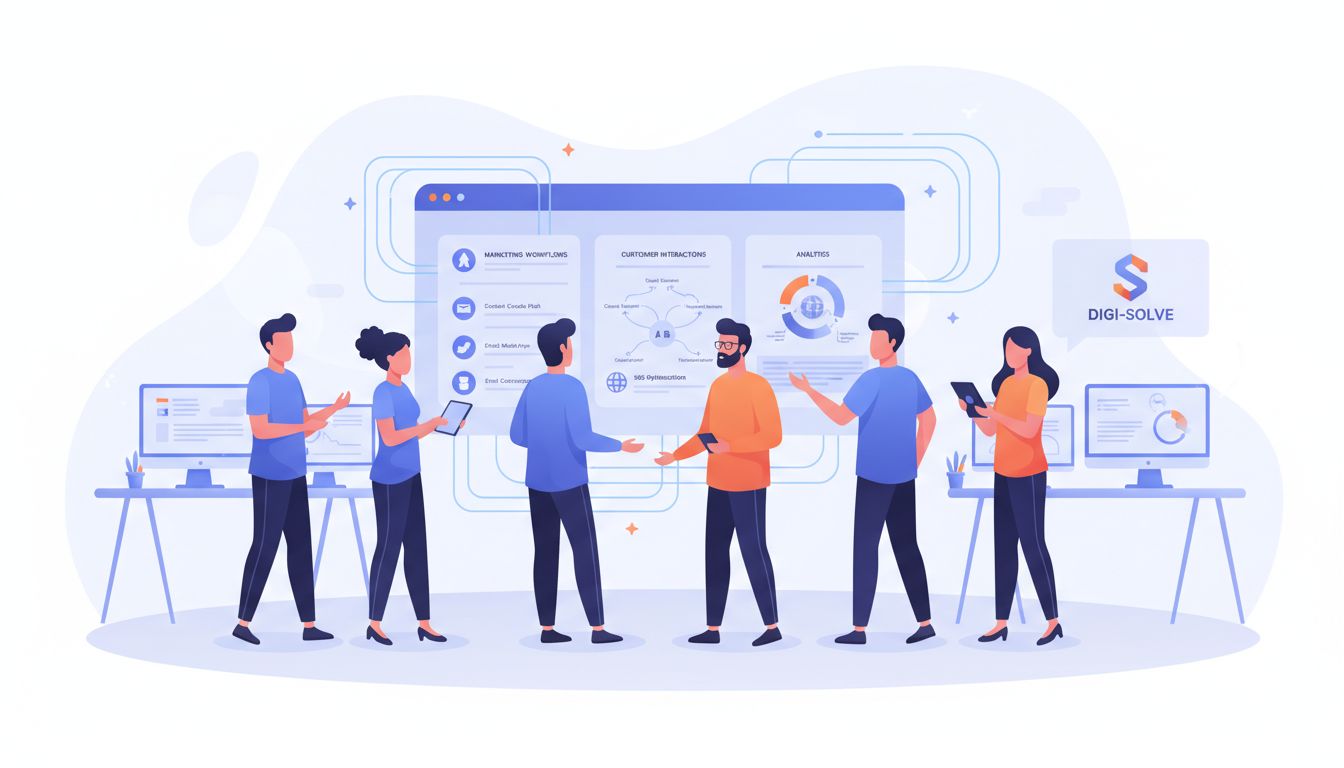Website Automation Explained: Streamline Digital Growth

Nearly 60 percent of digital professionals now depend on website automation to handle repetitive tasks and boost efficiency. As online operations grow more complex, businesses face mounting pressure to keep workflows smooth and error-free. Understanding how website automation works can help you simplify time-consuming processes, cut costs, and deliver a more consistent user experience. This guide breaks down what website automation means, why it matters, and how it can drive real results for your business.
Table of Contents
- Website Automation: Definition And Key Concepts
- Major Types Of Website Automation Tools
- How Website Automation Works In Practice
- Practical Applications For Businesses And Agencies
- Potential Challenges And Mitigation Strategies
Key Takeaways
| Point | Details |
|---|---|
| Importance of Website Automation | Website automation streamlines complex digital processes, enhancing efficiency and reducing manual errors for businesses. |
| Core Automation Components | Effective automation requires intelligent task recognition, workflow optimization, integration capabilities, and real-time adaptation. |
| Types of Automation Tools | Various tools exist for testing, marketing, content management, customer interaction, and integration, each serving specific business needs. |
| Challenges and Solutions | Address challenges like technical complexity and data security with proactive strategies and suitable automation tools to ensure operational success. |
Website Automation: Definition And Key Concepts
Website automation represents a powerful digital strategy transforming how businesses interact with online platforms, enabling entrepreneurs to streamline complex digital processes without extensive technical expertise. According to research from arxiv.org, website automation involves creating intelligent systems that can reverse-engineer website functionalities into reusable tools, dramatically reducing manual intervention.
At its core, website automation encompasses a range of technological approaches designed to eliminate repetitive tasks, enhance operational efficiency, and create seamless digital experiences. The DiLogics research highlights how natural language processing can now assist users in creating sophisticated web automation programs, making complex digital workflows accessible to non-technical professionals.
Key components of effective website automation include:
- Intelligent Task Recognition: Systems that can identify and replicate repetitive digital processes
- Workflow Optimization: Automatic sequencing of digital tasks with minimal human intervention
- Integration Capabilities: Connecting different digital platforms and tools seamlessly
- Real-time Adaptation: Dynamically adjusting automated processes based on changing website conditions
For entrepreneurs and agencies seeking to leverage website automation, understanding these fundamental concepts is crucial. By implementing strategic automation, businesses can reduce overhead, minimize human error, and create more consistent digital experiences across multiple platforms.
Learn more about why website automation matters in our comprehensive guide.
Major Types Of Website Automation Tools
Website automation tools represent a critical technological ecosystem designed to streamline digital workflows and enhance operational efficiency across various business domains. As highlighted by Wikipedia, these tools range from sophisticated testing frameworks like Selenium, which supports multiple programming languages and browsers, to comprehensive platforms enabling seamless digital interactions.
The primary categories of website automation tools can be strategically classified into several key segments:
Here’s a summary of major types of website automation tools and their core functions:
| Tool Type | Main Functions | Example Platforms |
|---|---|---|
| Testing & QA | Automated testing Error detection |
Selenium TestComplete |
| Marketing Automation | Email campaigns Lead management |
HubSpot Mailchimp |
| Content Management | Scheduling Publishing Optimization |
Buffer WordPress |
| Customer Interaction | AI chatbots User engagement |
Drift Intercom |
| Integration & Workflow | Cross-platform linking Task sequencing |
Zapier IFTTT |
- Testing and Quality Assurance Tools: Platforms like TestComplete that enable functional automated testing across web, mobile, and desktop environments
- Marketing Automation Tools: Systems focused on email campaigns, lead nurturing, and customer engagement
- Content Management Automation: Platforms that schedule, publish, and optimize digital content across multiple channels
- Customer Interaction Tools: AI-powered chatbots and interactive systems that manage user communications
- Integration and Workflow Automation: Tools connecting different digital platforms and streamlining cross-platform processes
For entrepreneurs and digital professionals, selecting the right automation tool depends on specific business requirements, technical complexity, and desired outcomes.
![]() Modern website automation solutions increasingly leverage artificial intelligence to provide more intelligent, adaptive, and context-aware automation capabilities.
Modern website automation solutions increasingly leverage artificial intelligence to provide more intelligent, adaptive, and context-aware automation capabilities.

Explore powerful examples of business automation strategies that drive success.
How Website Automation Works In Practice
Website automation transforms digital operations by creating intelligent systems that can replicate and optimize human interactions across online platforms. According to research from arxiv.org, practical implementation of web automation involves interactive programming-by-demonstration, where systems learn and reproduce complex digital workflows with minimal human intervention.
The practical mechanics of website automation typically follow a structured approach:
- Task Identification: Mapping out repetitive digital processes that consume significant time and resources
- Workflow Mapping: Analyzing each step of the digital interaction to create a comprehensive automation blueprint
- Tool Selection: Choosing appropriate automation technologies that match specific business requirements
- Implementation: Configuring automated systems to execute tasks consistently and accurately
- Continuous Optimization: Monitoring and refining automated processes to improve efficiency
Research from arxiv.org highlights how advanced automation technologies can generate autonomous HTML interfaces, enabling businesses to create more responsive and adaptive digital experiences. These systems leverage artificial intelligence and machine learning to understand context, predict user needs, and dynamically adjust website interactions.
For entrepreneurs looking to streamline their digital operations, understanding the practical application of website automation is crucial. By implementing strategic automated workflows, businesses can reduce manual overhead, minimize human error, and create more consistent online experiences.
Discover essential AI marketing strategies for digital growth.
Practical Applications For Businesses And Agencies
Website automation has emerged as a transformative strategy for businesses and agencies seeking to optimize their digital operations and competitive edge. According to research from arxiv.org, the WALT framework enables organizations to automate complex browser tasks, dramatically enhancing efficiency and scalability across digital platforms.
Practical applications of website automation span multiple business domains:
- Marketing Automation: Scheduling social media posts, managing email campaigns, and tracking customer engagement
- Client Onboarding: Streamlining registration processes, automatically generating welcome packages
- Sales Funnel Management: Creating automated follow-up sequences, tracking lead interactions
- Customer Support: Implementing AI chatbots, managing initial customer inquiries
- Reporting and Analytics: Automatically collecting and synthesizing performance data
- Content Management: Scheduling content publishing, managing multi-platform distribution
Research from arxiv.org highlights how DiLogics systems now allow non-technical professionals to create sophisticated web automation programs, democratizing advanced digital workflows. This breakthrough means agencies and small businesses can now implement complex automation strategies without extensive coding knowledge.
For agencies managing multiple clients, website automation represents an unfair competitive advantage. By reducing manual overhead, minimizing human error, and creating consistent digital experiences, businesses can scale operations more efficiently and allocate resources toward strategic growth initiatives.
Discover essential AI tools for small business growth success.
Potential Challenges And Mitigation Strategies
Website automation, while powerful, presents complex technological and operational challenges that businesses must strategically address. According to research from arxiv.org, the WebRobot study reveals that interactive programming-by-demonstration can effectively mitigate many technical obstacles encountered during web automation implementation.
Key challenges and corresponding mitigation strategies include:
- Technical Complexity: Implement incremental automation with robust testing protocols
- Integration Limitations: Choose flexible automation tools with extensive API compatibility
- Data Security Concerns: Utilize encrypted communication channels and strict access controls
- Workflow Unpredictability: Develop adaptive algorithms that can handle dynamic website changes
- Performance Overhead: Design lightweight, efficient automation scripts
- User Experience Disruption: Create seamless background automation processes
Research from arxiv.org emphasizes the importance of autonomic computing as a comprehensive approach to managing intricate IT system challenges. This strategy involves creating self-managing systems that can dynamically adapt to changing digital environments, reducing manual intervention and minimizing potential disruptions.
Successful website automation requires a proactive approach that balances technological innovation with pragmatic risk management. By anticipating potential challenges and developing robust mitigation strategies, businesses can harness automation’s transformative potential while maintaining operational stability and reliability.
Explore how to build an agency website that converts fast.
Unlock Seamless Website Automation for Effortless Digital Growth
If you are overwhelmed by managing multiple digital tools and want to automate your website marketing and content workflows without technical headaches this is the solution you need. The article highlights key challenges like workflow unpredictability and the need for adaptive automation systems that reduce manual overhead while boosting consistency. These pain points resonate with entrepreneurs and agencies looking to streamline digital operations efficiently.
We.inc delivers a powerful all-in-one platform combining AI-driven marketing automation, multi-platform social scheduling, and no-code website building. This means you can easily set up intelligent sales funnels, automate customer engagement with AI chatbots, and publish content seamlessly from one unified dashboard. Imagine cutting time spent on repetitive tasks and focusing on growth with a tool designed for rapid deployment and effortless scaling.
Experience the unfair advantage top digital marketers use to maintain competitive edge and accelerate success.
Elevate your website automation strategy today by exploring how AI marketing strategies fuel digital growth and discover essential AI tools for small business success. Start building your automated future now at We.inc.
Transform your digital presence and take control of your growth journey with We.inc
Maximize your efficiency with an automation platform designed for entrepreneurs and agencies alike

Get started today with We.inc and see how easy it is to create high-converting websites and automate marketing workflows in one place. Visit https://we.inc and begin your digital growth now.
Frequently Asked Questions
What is website automation?
Website automation is a digital strategy that enables businesses to streamline and optimize their online processes by automating repetitive tasks, enhancing operational efficiency, and creating seamless digital experiences.
How does website automation work in practice?
Website automation involves identifying repetitive tasks, mapping workflows, selecting automation tools, implementing them for consistent execution, and continuously optimizing the automated processes to improve efficiency and effectiveness.
What are some common tools used for website automation?
Common types of website automation tools include testing and QA tools like Selenium, marketing automation platforms like HubSpot, content management tools like Buffer, customer interaction tools like Drift, and integration platforms like Zapier.
What challenges can arise when implementing website automation?
Challenges may include technical complexity, integration limitations, data security concerns, workflow unpredictability, performance overhead, and potential disruption of user experience. Addressing these challenges requires strategic planning and robust mitigation strategies.
Recommended
- Complete Guide to Why Website Automation Matters
- 7 Powerful Examples of Business Automation for Success
- Step by Step Website Design for Business Success
- 7 Essential AI Marketing Strategies for Digital Growth
- Understanding the Importance of Customer Communication – My WordPress
- Web Based Testing Strategies for CRO and Growth Teams 2025
%20(1).svg)


